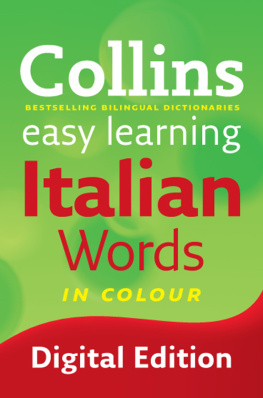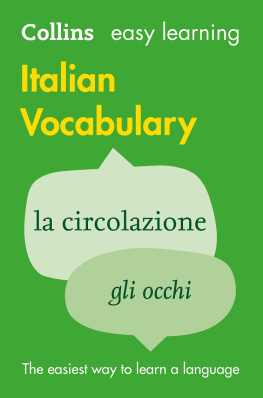PRACTICE MAKES PERFECT
Italian Vocabulary
PRACTICE MAKES PERFECT
Italian Vocabulary
Second EditionDaniela Gobetti

Copyright 2012 by Daniela Gobetti. All rights reserved. Except as permitted under the United States Copyright Act of 1976, no part of this publication may be reproduced or distributed in any form or by any means, or stored in a database or retrieval system, without the prior written permission of the publisher. ISBN: 978-0-07-176097-3 MHID: 0-07-176097-0 The material in this eBook also appears in the print version of this title: ISBN: 978-0-07-176096-6, MHID: 0-07-176096-2. All trademarks are trademarks of their respective owners. Rather than put a trademark symbol after every occurrence of a trademarked name, we use names in an editorial fashion only, and to the benefit of the trademark owner, with no intention of infringement of the trademark.
Where such designations appear in this book, they have been printed with initial caps. McGraw-Hill eBooks are available at special quantity discounts to use as premiums and sales promotions, or for use in corporate training programs. To contact a representative please e-mail us at bulksales@mcgraw-hill.com. Trademarks: McGraw-Hill, the McGraw-Hill Publishing logo, Practice Makes Perfect, and related trade dress are trademarks or registered trademarks of The McGraw-Hill Companies and/or its affiliates in the United States and other countries and may not be used without written permission. All other trademarks are the property of their respective owners. TERMS OF USE This is a copyrighted work and The McGraw-Hill Companies, Inc. (McGraw-Hill) and its licensors reserve all rights in and to the work. (McGraw-Hill) and its licensors reserve all rights in and to the work.
Use of this work is subject to these terms. Except as permitted under the Copyright Act of 1976 and the right to store and retrieve one copy of the work, you may not decompile, disassemble, reverse engineer, reproduce, modify, create derivative works based upon, transmit, distribute, disseminate, sell, publish or sublicense the work or any part of it without McGraw-Hills prior consent. You may use the work for your own noncommercial and personal use; any other use of the work is strictly prohibited. Your right to use the work may be terminated if you fail to comply with these terms. THE WORK IS PROVIDED AS IS. McGRAW-HILL AND ITS LICENSORS MAKE NO GUARANTEES OR WARRANTIES AS TO THE ACCURACY, ADEQUACY OR COMPLETENESS OF OR RESULTS TO BE OBTAINED FROM USING THE WORK, INCLUDING ANY INFORMATION THAT CAN BE ACCESSED THROUGH THE WORK VIA HYPERLINK OR OTHERWISE, AND EXPRESSLY DISCLAIM ANY WARRANTY, EXPRESS OR IMPLIED, INCLUDING BUT NOT LIMITED TO IMPLIED WARRANTIES OF MERCHANTABILITY OR FITNESS FOR A PARTICULAR PURPOSE.
McGraw-Hill and its licensors do not warrant or guarantee that the functions contained in the work will meet your requirements or that its operation will be uninterrupted or error free. Neither McGraw-Hill nor its licensors shall be liable to you or anyone else for any inaccuracy, error or omission, regardless of cause, in the work or for any damages resulting therefrom. McGraw-Hill has no responsibility for the content of any information accessed through the work. Under no circumstances shall McGraw-Hill and/or its licensors be liable for any indirect, incidental, special, punitive, consequential or similar damages that result from the use of or inability to use the work, even if any of them has been advised of the possibility of such damages. This limitation of liability shall apply to any claim or cause whatsoever whether such claim or cause arises in contract, tort or otherwise.
Contents
Introduction
This book provides readers with basic Italian words in a variety of fields, and with exercises to practice how those words are used.
It is divided into sixteen units corresponding to as many themes. In each unit words are clustered according to sub-themes, but within each sub-theme I have chosen to list nouns separate from verbs, pronouns, and so forth, rather than list them thematically. Italian is a rule-based, rather than a pattern-based language. Familiarity with grammar rules is therefore indispensable even at the elementary level. While doing the exercises, users are encouraged to keep a grammar book, a verb book, and a dictionary at hand to clarify their doubts.  I have clustered together adjectives, adverbs, and phrases that are used to qualify nouns or verbs, because it often happens that a qualifier conveyed by an adjective in English is conveyed by an adverb or phrase in Italian, and vice versa.
I have clustered together adjectives, adverbs, and phrases that are used to qualify nouns or verbs, because it often happens that a qualifier conveyed by an adjective in English is conveyed by an adverb or phrase in Italian, and vice versa.  I have clustered together adjectives, adverbs, and phrases that are used to qualify nouns or verbs, because it often happens that a qualifier conveyed by an adjective in English is conveyed by an adverb or phrase in Italian, and vice versa.
I have clustered together adjectives, adverbs, and phrases that are used to qualify nouns or verbs, because it often happens that a qualifier conveyed by an adjective in English is conveyed by an adverb or phrase in Italian, and vice versa.
Adjectives and phrases composed of an adjective and a preposition, such as bello(beautiful), grande(large, great), piccolo(small, little), solo(alone) and da solo(alone), da piccolo(as a kid/young boy), da grande(as an adult), etc., must be coordinated in gender and number with the noun to which they refer. Adverbs such as bene (well), velocemente (fast), etc., are unchangeable, as are the complements a disagio(not at ease, uneasy) and di corsa (in a hurry), which are formed of a noun and a preposition.  Italian is rich in compound nouns, which can be formed by an adjective and a noun or a noun followed by a phrase (called a complement in Italian) that changes its basic meaning: la malattia tropicale (tropical disease), la barca a vela (sailing boat), la tazza da t (teacup). Only when compound nouns are formed by adding an adjective do the rules of coordination apply: la guida turistica (tourist guide), le guide turistiche (tourist guides). When the context is clear, the adjective or complement used as a qualifier can be dropped. I have listed in square brackets the word that can be omitted: i [pomodori] pelati (peeled tomatoes); le patatine [fritte] (potato chips).
Italian is rich in compound nouns, which can be formed by an adjective and a noun or a noun followed by a phrase (called a complement in Italian) that changes its basic meaning: la malattia tropicale (tropical disease), la barca a vela (sailing boat), la tazza da t (teacup). Only when compound nouns are formed by adding an adjective do the rules of coordination apply: la guida turistica (tourist guide), le guide turistiche (tourist guides). When the context is clear, the adjective or complement used as a qualifier can be dropped. I have listed in square brackets the word that can be omitted: i [pomodori] pelati (peeled tomatoes); le patatine [fritte] (potato chips).
In general, square brackets are used to indicate that the word or words in question can be omitted.  I have listed nouns in the masculine, unless the noun happens to be feminine: la guida (guide), la persona (person). The notation (m. and f. / f. and m.) (masculine and feminine / feminine and masculine) means that the word in question can refer to either gender, even if the gender of the word is only masculine or feminine.
I have listed nouns in the masculine, unless the noun happens to be feminine: la guida (guide), la persona (person). The notation (m. and f. / f. and m.) (masculine and feminine / feminine and masculine) means that the word in question can refer to either gender, even if the gender of the word is only masculine or feminine.
Since the masculine is the default gender in Italian, the masculine plural of nouns ending in -a can be used for women as well:
Next page




 Copyright 2012 by Daniela Gobetti. All rights reserved. Except as permitted under the United States Copyright Act of 1976, no part of this publication may be reproduced or distributed in any form or by any means, or stored in a database or retrieval system, without the prior written permission of the publisher. ISBN: 978-0-07-176097-3 MHID: 0-07-176097-0 The material in this eBook also appears in the print version of this title: ISBN: 978-0-07-176096-6, MHID: 0-07-176096-2. All trademarks are trademarks of their respective owners. Rather than put a trademark symbol after every occurrence of a trademarked name, we use names in an editorial fashion only, and to the benefit of the trademark owner, with no intention of infringement of the trademark.
Copyright 2012 by Daniela Gobetti. All rights reserved. Except as permitted under the United States Copyright Act of 1976, no part of this publication may be reproduced or distributed in any form or by any means, or stored in a database or retrieval system, without the prior written permission of the publisher. ISBN: 978-0-07-176097-3 MHID: 0-07-176097-0 The material in this eBook also appears in the print version of this title: ISBN: 978-0-07-176096-6, MHID: 0-07-176096-2. All trademarks are trademarks of their respective owners. Rather than put a trademark symbol after every occurrence of a trademarked name, we use names in an editorial fashion only, and to the benefit of the trademark owner, with no intention of infringement of the trademark.  I have clustered together adjectives, adverbs, and phrases that are used to qualify nouns or verbs, because it often happens that a qualifier conveyed by an adjective in English is conveyed by an adverb or phrase in Italian, and vice versa.
I have clustered together adjectives, adverbs, and phrases that are used to qualify nouns or verbs, because it often happens that a qualifier conveyed by an adjective in English is conveyed by an adverb or phrase in Italian, and vice versa.